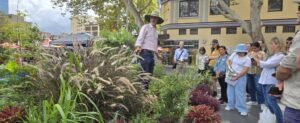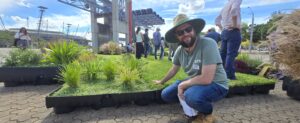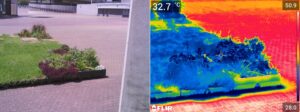
Go green, stay cool
By Zoe Cwojdzinski
Plants have proven countless benefits over centuries for human health and wellbeing, but a University of Technology Sydney collaboration highlights their impact as urban temperatures continue to climb.
Our cities are getting hotter. More than half the world’s population now lives in urban areas, a number expected to climb to 70 per cent by 20501[GS1] . With this shift, the urban heat island (UHI) effect, where city areas experience significantly higher temperatures than their rural surroundings, is becoming more noticeable and more challenging. Dr Peter Irga, a senior lecturer in the School of Civil and Environmental Engineering at the University of Technology Sydney (UTS), is tackling this issue using a green solution. By harnessing the power of living infrastructure, he is helping to bring greener landscapes to concrete jungles, and cooler temperatures to city spaces, creating healthier and happier communities.

The power of parklets
One innovative business, Future Village, is leading the way in making cities greener. As part of a project in Blacktown, they installed their free-standing garden trays in the town centre. Initially, the idea was mainly aesthetic, but they quickly noticed other benefits. ‘After the installation, people started sitting and relaxing there even on the hottest summer days, when it would have normally been empty,’ recalls Ben Perry, Design and Placemaking Director from Future Village. This observation led Future Village to partner with UTS to study the cooling impact of these green spaces, with funding from the Office of the NSW Chief Scientist and Engineer.

‘Working with Future Village allowed us to take our lab research into the real world, making it publicly beneficial and building a strong and strategic research partnership,’ Peter explains. The project team set up additional sites in Parramatta Square and Auburn Square with garden trays, large planters and trees to study a range of effects:
- Temperature monitoring: The team used loggers to track the microclimate and thermal imaging to measure surface temperatures.
2. Heat island mitigation modelling: Models were used to see how the installations could cool the area and influence airflow on hot days.
3. Heat island mitigation modelling: Models were used to see how the installations could cool the area and influence airflow on hot days.
The feedback and data exceeded everyone’s expectations. QR codes at each test site allowed locals to share their thoughts, while council representatives gathered additional feedback. The numbers backed up the positive response. On days when the ambient temperature exceeded 35°C at the control sites, air temperatures at the green sites were 12–14°C cooler. ‘The results were promising, but we didn’t expect such a big difference,’ Peter says, ‘Suddenly, a forgotten space became a gathering spot. People who used to avoid the area were now spending time there, chatting, even playing music.’ Thanks to these encouraging results, both councils have invested in the floating gardens and added extra seating, making it a permanent community feature.
A tale of two cities
The urban heat island effect impacts certain areas harder, and Western Sydney is a prime example, experiencing extreme temperatures compared to their coastal counterparts. Green infrastructure like floating gardens has the potential to bring relief to these communities, creating cooler, more liveable environments and addressing inequities in urban living conditions. ‘We saw this in Auburn, where people congregated at the installations,’ said Peter, ‘Whilst we were measuring heat and temp reduction, it was a clear co-benefit that the spaces were turning into places, and the community were really behind it.’

The path forward is green
Following the initial success, Future Village has expanded, adding more floating gardens for other councils, including a significant installation of 80 garden trays for the City of Mildura. Other trials have been underway, with improvements aimed at increasing the water reservoir capacity to enhance cooling potential. Installations are in place at the Sydney Olympic Park, additional locations in Parramatta, and a rooftop garden had been established at UTS’s city campus.
‘The beauty of this system lies in its flexibility,’ says Peter. ‘It is modular and quick to install or remove, which means we can green large areas in under a day without heavy construction or disruption.’ Because of its lightweight design, these gardens are ideal for transforming existing rooftops into green roofs. As Peter explains, this is where they see the biggest opportunity to cool our cities and impact urban living.
Along with the UHI, the urban pollution island (UPI) effect is another key challenge impacting city liveability. UPI is the consequence of concentrated air pollutants emitted from industries, transport and human activities, making urban areas more polluted than rural areas. However, the two challenges are often addressed separately in research. Peter and his team are changing this, with their recently published research paper[GS2] * on green infrastructure to control the impacts of UHI and UPI. Peter is hopeful about a cooler, greener future because of these practices: ‘We are particularly excited about retrofitting existing buildings across urban areas. Our new research is targeting the planter technology for green roofs, as we feel this is the way we can make the biggest impact in our urban environments.’

What does the community think?
The installations have received strong community support, according to feedback collected by the City of Parramatta Council. Signage with QR codes was installed at each site in February, encouraging public participation, and of the community respondents gave an average rating of 4.69 out of 5. At Parramatta Public School, students from Years 3 to 6 also provided feedback, contributing ideas for how the green space could be used and strongly supporting the initiative with almost all students (95%) stating nature in their playground is important. Parramatta Council Smart City Strategy staff noted that almost all public respondents (96.2%) strongly supported more trials like this, with most people (88.5%) strongly agreeing that the planters improved the look and feel of the space.
The project was delivered through a collaboration between Future Village, WaterUps, UTS, and several local authorities including Parramatta Council, Cumberland City Council, and the Sydney Olympic Park Authority. Plant contributions came from The Green Gallery, Alpine Nurseries and Sutherland Shire Council Nursery.
The UTS research team and collaborators include Peter Irga, Fraser Torpy, Gabbrielle Duani, Ralph Fares, Luowen Lyu, Nicholas Juraszek and Sebastian Pfautsch (Western Sydney University).
* Wu, Q., Huang, Y., Irga, P., Kumar, P., Li, W., Wei, W., Shon, H. K., Lei, C., & Zhou, J. L. (2024). Synergistic control of urban heat island and urban pollution island effects using green infrastructure. Journal of Environmental Management, 370, 122985. https://doi.org/10.1016/j.jenvman.2024.122985
References
- Dashora, L. K., Firoz, C. M., & Shaw, R. (2025). Understanding urbanization, urban sustainability, and environmental transition challenges in Global South. In Urban sustainability: Navigating environmental transition challenges in Global South (pp. 1–8). Springer Nature Singapore.
